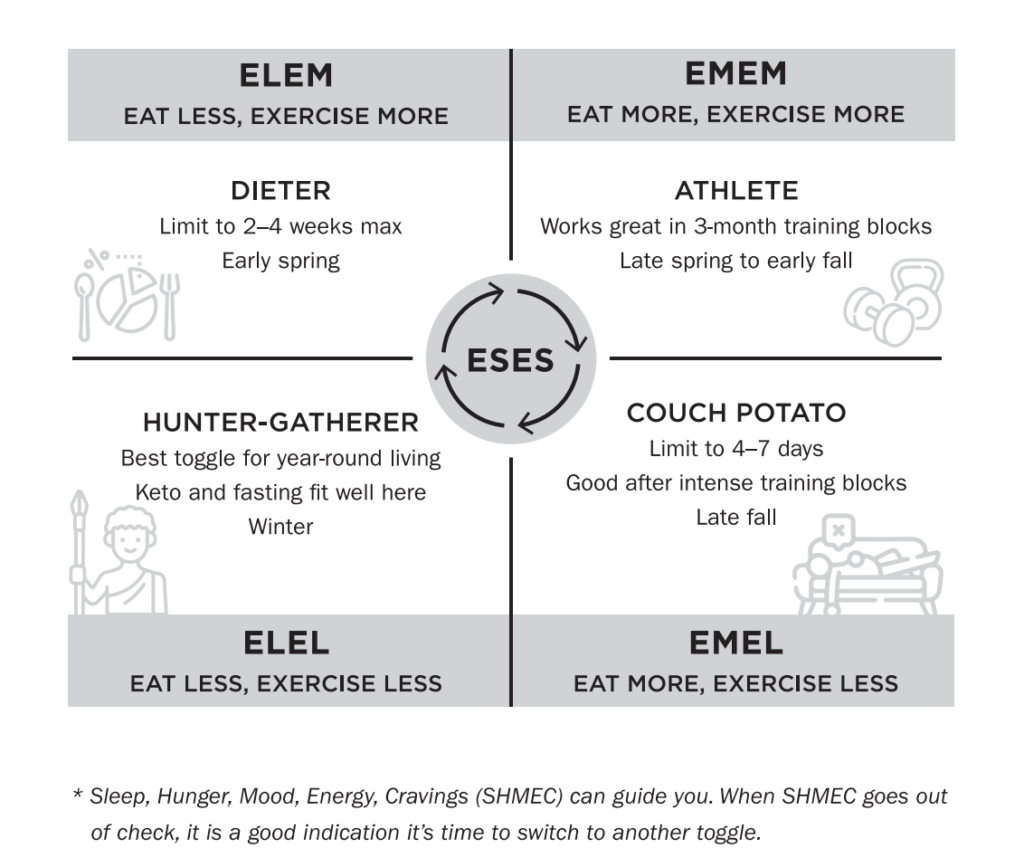When being a couch potato is good for your metabolism
Does it ever make sense to “eat more and exercise less”? Yes! But very carefully. In fact, we can utilize this toggle strategically to push through a weight loss plateau.
Eat More, Exercise Less
This “couch potato” toggle might sound counterintuitive to our typical balanced approach of EMEM or ELEL. And for good reason. For those of you who don’t know what this means, EMEM and ELEL stand for “eat more, exercise more” and “eat less, exercise less” – respectively. These are metabolic toggles that help people lose fat and/or gain muscle by creating slight caloric deficits through either less food intake (ELEL) or more movement (EMEM).
When “SHMEC goes out of check”
ELEL and EMEM are much more sustainable than typical yo-yo dieting methods that drastically cut calories and/or enforce “exercising more”. We call this the “eat less, exercise more” or ELEM toggle. In the short run, this approach might work. But the cost is high, hormonally speaking. The body’s metabolism pushes back when we stay in this state for too long. Our body’s biofeedback typically gives us clues that this is happening. When we experience our sleep, hunger, mood, energy, and/or cravings going out of check, then we know that the metabolism is compensating for hormonal imbalance. And more often than not, this hormonal imbalance is a negative trickle-down effect from a stressed metabolism.
The Couch Potato Toggle – aka EMEL
So when, if ever, does it make sense to go the other way and eat MORE while exercising LESS? Given what I’ve just shared about the metabolism, this approach is equally as imbalanced as ELEM and therefore, a stressor to the metabolism. You’re right. However, there is one caveat that concerns the validity of this metabolic principle in the context of body change. The metabolism is adaptive and reactive. It responds better to change and challenge. Cycling between the four metabolic toggles (ELEL, EMEM, ELEM, EMEL) may reduce metabolic compensation (SHMEC going out of check), and more importantly, help people break out of plateaus. But only when used strategically and for specific periods of time.
When and how to use The Couch Potato Toggle
Short periods of time in calorie deficits and/or surpluses, and then returning to isocaloric states (ie. maintenance), is one method that Dr. Jade Teta has used with good clinical success in his own personal practice. In other words, for 4-7 days maximum, and/or after periods of high metabolic stress (for example, after intense training blocks), this toggle can be used as a little “vacay” for your metabolism. A little R&R if you will. But not if used for too long. After 4-7 days, this toggle becomes a stressor – just like “eat less, exercise more” (the yo-yo dieter toggle). Returning to isocaloric states, or a more sustainable toggle like ELEL removes the metabolic stress.
With any toggle you choose to utilize, you have to find a way to narrow the calorie gap and convince the metabolism that it does NOT need to be stressed out. Cycling between the toggles is one specific way we can do this. So, how much time should we spend in each toggle to prevent metabolic compensation reactions, ie SHMEC getting out of check?
Here is a diagram from Dr. Jade Teta’s Next Level Metabolism: The Art and Science of Metabolic Mastery, that can help guide our use of these different metabolic toggles.

“By understanding the four metabolic toggles you can use to increase or decrease stress on your metabolism, you can determine what state will best help you achieve your goals.”
– Dr. Jade Teta, Next Level Metabolism: The Art and Science of Metabolic Mastery.
If your body change results slow or plateau, then you know that you’ve engaged this toggle for too long, and it is time to give it a break.
The good news is that when you use the ELEM and EMEL toggle sparingly for short periods with long breaks in between, it starts working for us rather than against us. There is nothing inherently bad about any of the toggles—it’s just how we use them and how we adjust our approach when the metabolism starts speaking to us.
By giving yourself breaks from this metabolic toggle and using it intelligently and sparingly, you will be able to benefit from it.
Let us know if you’ve tried it and how it worked for you!
Photo by Inside Weather on Unsplash

